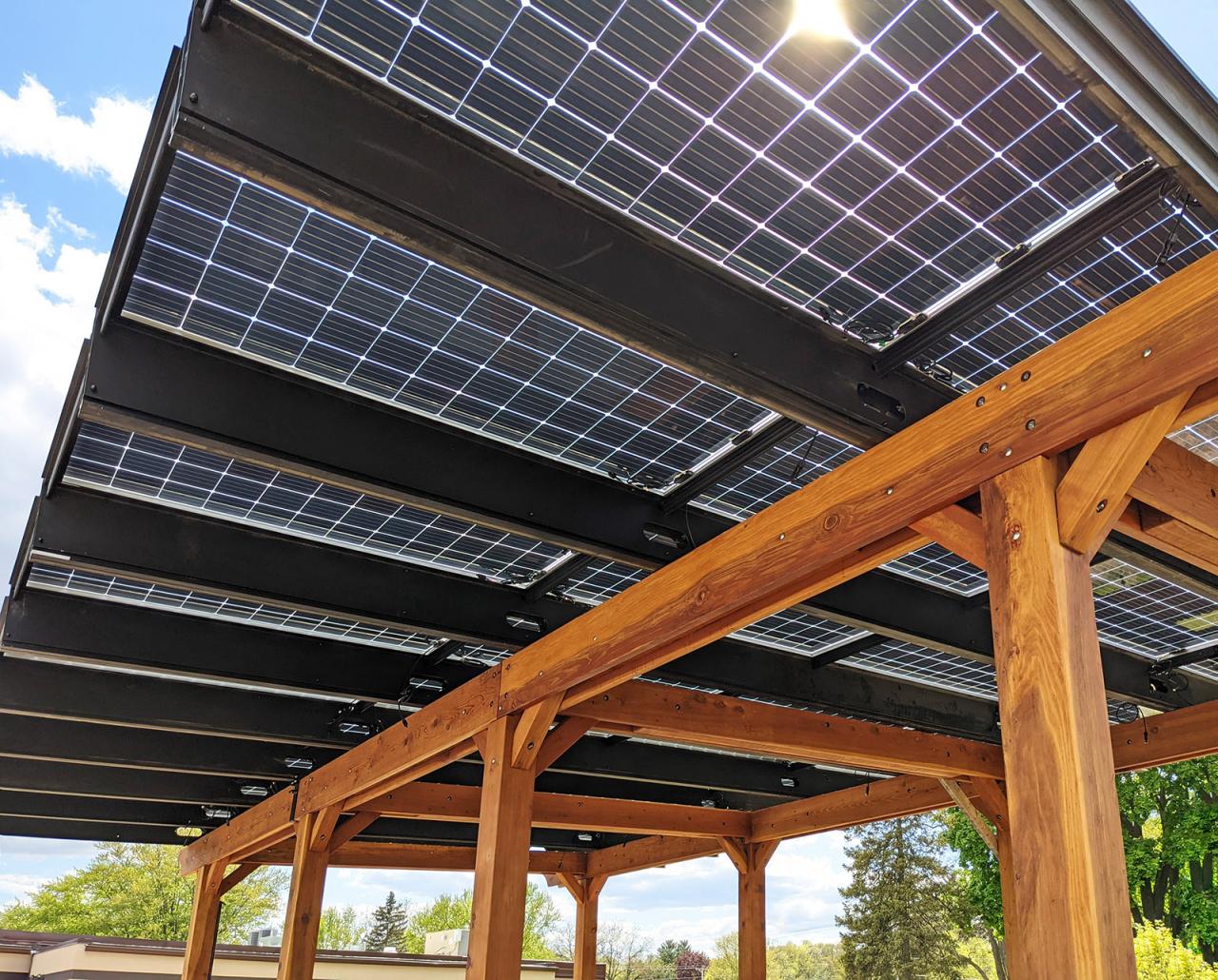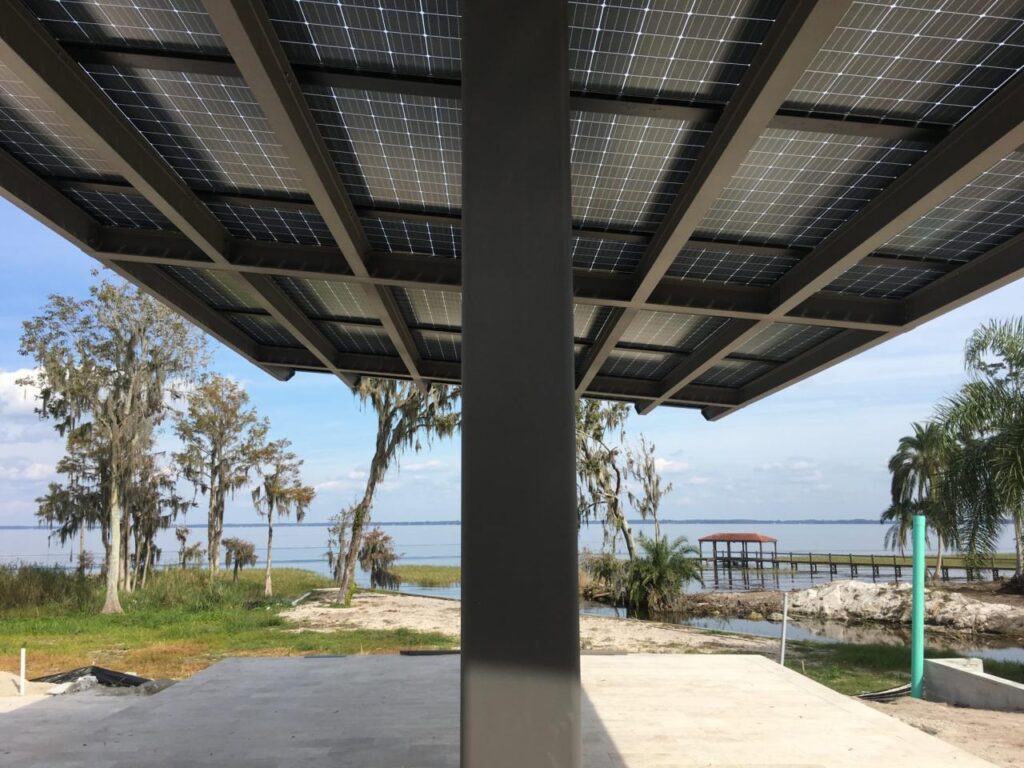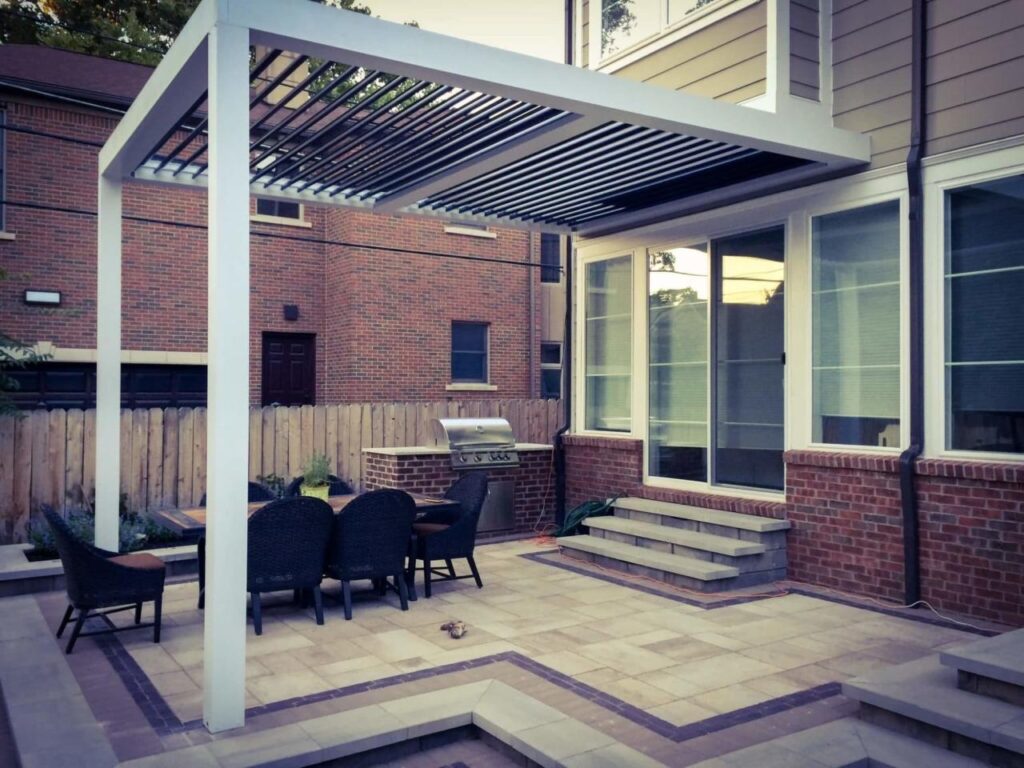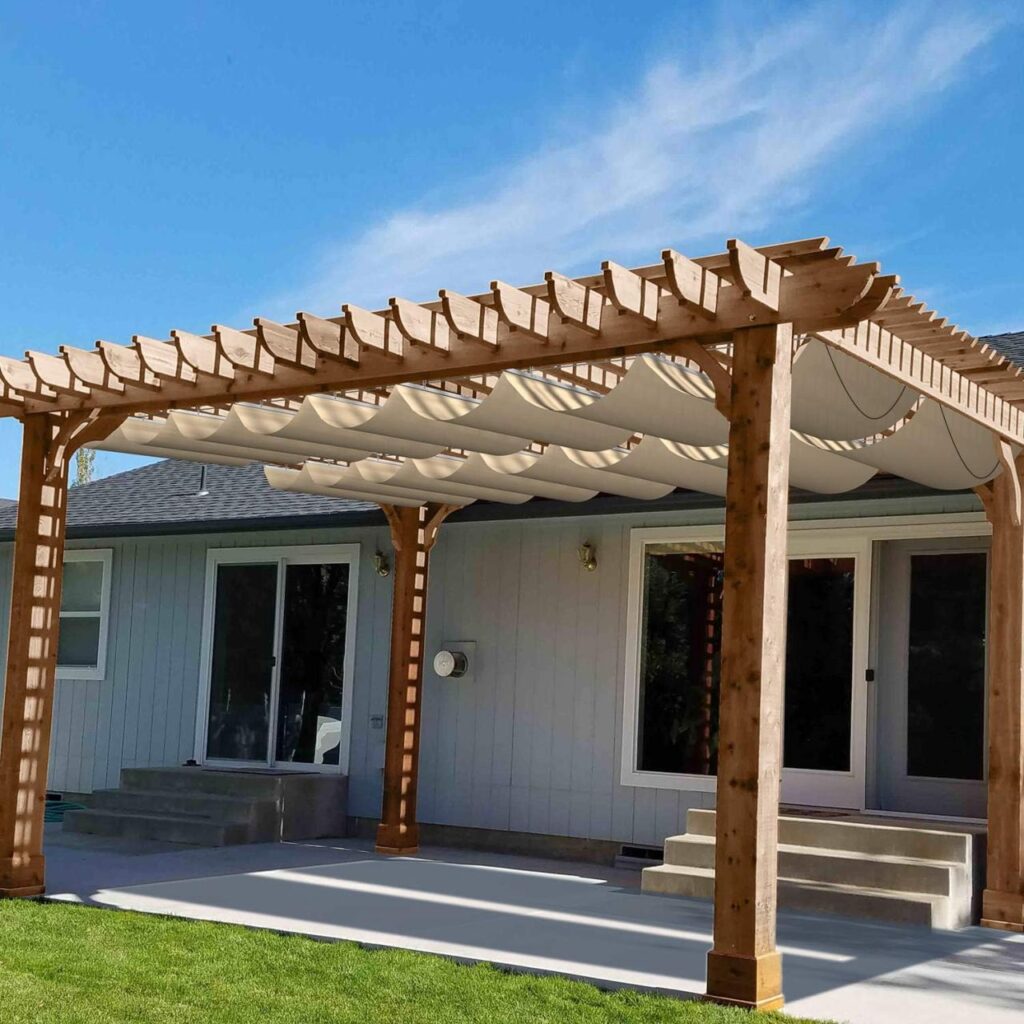Step into the realm of solar pergolas, where functionality and beauty intertwine seamlessly. These innovative structures not only provide shelter from the elements but also harness the power of the sun, offering a sustainable and captivating outdoor experience.
From modern designs to traditional aesthetics, solar pergolas come in a myriad of styles and materials, catering to every taste and architectural preference. Their ability to generate clean energy while enhancing the ambiance of your outdoor space makes them a truly remarkable addition to any home.
Introduction to Solar Pergolas
Solar pergolas are outdoor structures that combine the functionality of a traditional pergola with the benefits of solar energy. They are designed to provide shade and shelter while generating electricity through integrated solar panels.
Solar pergolas offer numerous advantages. They help reduce energy costs by generating clean, renewable energy that can be used to power homes, businesses, or other structures. Additionally, they enhance the aesthetics of outdoor spaces, creating a visually appealing and functional addition to any property.
Benefits of Solar Pergolas
The benefits of solar pergolas extend beyond energy efficiency and aesthetics. They also offer:
- Durability: Solar pergolas are typically made from sturdy materials like aluminum or steel, ensuring longevity and resistance to weather elements.
- Low Maintenance: Solar panels require minimal maintenance, making solar pergolas a hassle-free investment.
- Environmental Sustainability: By generating renewable energy, solar pergolas contribute to a greener environment and reduce carbon footprint.
- Increased Property Value: Solar pergolas can increase the value of a property by providing energy savings, enhancing aesthetics, and offering a unique outdoor living space.
Types of Solar Pergolas
Solar pergolas come in a wide variety of designs, materials, and features, each with its own unique advantages. From traditional latticework to sleek contemporary designs, there’s a solar pergola to complement any home or outdoor space.
The type of solar pergola you choose will depend on your specific needs and preferences. If you’re looking for a classic look, a traditional latticework pergola with climbing vines is a beautiful option. If you prefer a more modern look, a sleek aluminum pergola with integrated solar panels is a great choice. And if you’re looking for a pergola that can provide both shade and shelter from the elements, a retractable solar pergola is a perfect solution.
Design
- Traditional Latticework Pergolas: These pergolas feature a classic latticework design that allows for climbing vines to create a beautiful and shady canopy.
- Contemporary Pergolas: These pergolas have a more modern look, with clean lines and sleek materials. They often feature integrated solar panels for a seamless look.
- Retractable Pergolas: These pergolas have a retractable roof that can be opened or closed to provide shade or shelter from the elements.
Materials
- Wood: Wood is a classic material for pergolas, and it comes in a variety of species and finishes. Cedar and redwood are popular choices for their natural resistance to rot and decay.
- Aluminum: Aluminum is a lightweight and durable material that is often used for contemporary pergolas. It is also resistant to rust and corrosion.
- Vinyl: Vinyl is a low-maintenance material that is available in a variety of colors and styles. It is also resistant to fading and cracking.
Features
- Integrated Solar Panels: Solar panels can be integrated into the roof or frame of a pergola to provide electricity for lighting, fans, or other devices.
- Retractable Roofs: Retractable roofs allow you to control the amount of shade or shelter you need from the elements.
- Built-in Lighting: Built-in lighting can extend the use of your pergola into the evening hours.
- Fans: Fans can help to keep you cool and comfortable on hot days.
Design Considerations for Solar Pergolas
Designing solar pergolas requires careful consideration of various factors to maximize their functionality and aesthetic appeal. Here are some key aspects to keep in mind:
Location and Orientation, Solar pergolas
The location and orientation of your solar pergola significantly impact its energy efficiency. Choose a spot with unobstructed access to sunlight throughout the day. Consider the angle of the sun’s rays and the orientation of your property to optimize solar energy absorption.
Size and Dimensions
The size and dimensions of your solar pergola should be determined based on the available space and your desired coverage area. Larger pergolas can generate more solar energy, but they also require more support and materials.
Roofing Materials
The roofing material for your solar pergola plays a crucial role in its efficiency. Choose materials with high light transmittance, such as polycarbonate panels or tempered glass, to maximize sunlight penetration. Consider the durability and maintenance requirements of different roofing options.
Solar pergolas, the epitome of outdoor comfort and sustainability, have revolutionized backyard living. These structures not only provide shade and protection from the elements but also generate renewable energy. The hanso pergola , with its sleek design and integrated solar panels, is a testament to this innovation.
It seamlessly combines functionality with aesthetics, allowing homeowners to enjoy their outdoor spaces while contributing to a greener future. Solar pergolas continue to gain popularity as a versatile and eco-friendly solution for outdoor living.
Mounting and Support
The mounting and support system for your solar pergola must be robust and reliable. Choose durable materials that can withstand weather conditions and ensure proper stability. Consider factors such as wind load and potential snow accumulation.
Ventilation
Proper ventilation is essential for regulating temperature under your solar pergola. Design your pergola with adequate openings or vents to allow air circulation and prevent heat buildup.
Installation and Maintenance of Solar Pergolas
Installing solar pergolas requires careful planning and professional expertise. The process typically involves:
* Site assessment and design: Determine the optimal location, size, and orientation of the pergola to maximize solar energy absorption.
* Foundation construction: Create a sturdy foundation using concrete or pavers to support the pergola structure.
* Assembly and installation: Assemble the pergola components and secure them to the foundation using bolts or screws.
* Electrical wiring: Connect the solar panels to an electrical system for power generation.
Maintenance and Cleaning
Maintaining and cleaning solar pergolas is crucial to ensure their longevity and efficiency. Regular tasks include:
* Cleaning: Use a soft cloth or brush to remove dirt, debris, and bird droppings from the solar panels and pergola surfaces.
* Inspection: Periodically inspect the pergola for any signs of damage, loose connections, or corrosion.
* Panel cleaning: If the panels become excessively dirty, use a mild detergent solution and a soft cloth for cleaning. Avoid abrasive materials or harsh chemicals.
* Annual maintenance: Schedule an annual maintenance check with a qualified professional to ensure the pergola’s structural integrity, electrical safety, and optimal performance.
Case Studies of Solar Pergolas
Witness the transformative power of solar pergolas through real-world examples that showcase their benefits and challenges. Explore the experiences of those who have successfully harnessed the sun’s energy to enhance their outdoor living spaces.
Case Study: Residential Installation
In a picturesque suburban home, a family embarked on a journey to reduce their energy footprint and create an inviting outdoor retreat. They installed a solar pergola over their backyard patio, seamlessly integrating it with their existing décor.
The pergola’s sleek design complemented the home’s architecture, while the photovoltaic panels provided ample shade and generated electricity. The family enjoyed extended outdoor hours, relishing the natural light and fresh air while significantly reducing their energy consumption.
Solar pergolas, with their elegant designs and eco-friendly features, create a captivating ambiance in any outdoor space. As the sun sets, enhance the charm of your pergola by stringing lights on the trees nearby, illuminating your surroundings with a warm and inviting glow.
For expert guidance on stringing lights, follow this comprehensive guide: how to string lights on a tree. With its clear instructions and helpful tips, you’ll effortlessly transform your pergola into an enchanting oasis.
Case Study: Commercial Application
A thriving café sought an innovative solution to expand its outdoor seating capacity while reducing operating costs. They opted for a solar pergola that offered both shelter and sustainable energy generation.
The pergola’s retractable canopy provided adjustable shade throughout the day, ensuring a comfortable ambiance for patrons. The photovoltaic panels powered the café’s lighting, reducing its reliance on the grid and creating a more eco-friendly environment.
Market Trends and Innovations in Solar Pergolas
The solar pergola market is constantly evolving, with new technologies and designs emerging all the time. These innovations are driven by the growing demand for sustainable and stylish outdoor living spaces. Some of the most notable trends include:
Increased Efficiency: Solar pergolas are becoming more efficient at converting sunlight into electricity. This is due to the use of new solar cell technologies, such as monocrystalline and polycrystalline panels.
The rustic charm of solar pergolas invites you to unwind in their shaded embrace. As the sun dips below the horizon, transform your outdoor sanctuary with govee string lights. Their twinkling brilliance weaves a tapestry of enchantment, casting a warm glow upon the pergola’s intricate latticework.
As darkness descends, the solar pergolas and govee string lights dance together, creating a magical haven that beckons you to linger.
Improved Aesthetics: Solar pergolas are no longer just functional structures. They are now also designed to be beautiful and stylish. This is due to the use of new materials, such as aluminum and glass, and the development of new designs.
Enhanced Functionality: Solar pergolas are now being equipped with a variety of features that enhance their functionality. These features include adjustable louvers, built-in lighting, and even sound systems.
Emerging Technologies
Some of the most exciting emerging technologies in the solar pergola market include:
- Bifacial Solar Panels: Bifacial solar panels are able to generate electricity from both sides of the panel. This can significantly increase the efficiency of a solar pergola.
- Transparent Solar Panels: Transparent solar panels are able to generate electricity while allowing light to pass through. This makes them ideal for use in pergolas, as they can provide shade without blocking out the sun.
- Solar Shingles: Solar shingles are individual solar panels that are designed to look like traditional roof shingles. This makes them a great option for homeowners who want to add solar power to their homes without compromising the aesthetics of their roof.
Cost and ROI of Solar Pergolas
Solar pergolas come with upfront installation costs, but they offer long-term savings on energy bills. The cost of a solar pergola varies depending on factors such as size, materials, and location. Generally, homeowners can expect to pay between $10,000 to $40,000 for a solar pergola system.
The potential return on investment (ROI) for a solar pergola depends on several factors, including the cost of electricity in the area, the amount of sunlight the pergola receives, and the size of the solar system. In general, solar pergolas can provide a ROI of 5% to 15% per year. This means that the system can pay for itself in 7 to 20 years.
Factors Affecting Cost
The cost of a solar pergola is determined by several factors, including:
- Size: Larger pergolas require more materials and labor, which increases the cost.
- Materials: The type of materials used for the pergola frame and solar panels affects the cost. Aluminum is a more expensive option than vinyl, but it is also more durable.
- Location: The cost of installation can vary depending on the location of the property. Areas with higher labor costs will have higher installation costs.
- Permits: In some areas, permits are required for the installation of solar pergolas. The cost of permits varies depending on the location.
Calculating ROI
The ROI for a solar pergola can be calculated using the following formula:
ROI = (Energy savings + Other benefits) / Cost of system
Energy savings: The energy savings from a solar pergola can be calculated by multiplying the amount of electricity generated by the system by the cost of electricity in the area.
Other benefits: In addition to energy savings, solar pergolas can provide other benefits, such as increased property value, reduced carbon footprint, and improved aesthetics. These benefits can be difficult to quantify, but they can contribute to the overall ROI of the system.
Conclusion
In conclusion, solar pergolas offer a unique and sustainable way to enhance outdoor living spaces while generating renewable energy. Their versatility, efficiency, and aesthetic appeal make them an ideal solution for homeowners, businesses, and communities alike.
By embracing solar pergolas, we can create more sustainable and enjoyable outdoor environments while contributing to a cleaner and greener future.
Final Review
In conclusion, solar pergolas are a testament to the harmonious convergence of innovation and aesthetics. They offer a unique blend of energy efficiency, visual appeal, and functionality, transforming outdoor spaces into oases of comfort and sustainability. Whether you seek to reduce your carbon footprint or simply create a captivating outdoor retreat, solar pergolas stand as an exceptional choice, promising both environmental benefits and unparalleled enjoyment.








